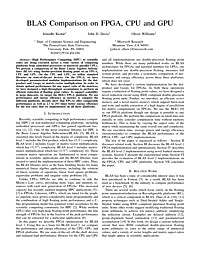
BLAS Comparison on FPGA, CPU and GPU
High Performance Computing (HPC) or scientific codes are being executed across a wide variety of computing platforms from embedded processors to massively parallel GPUs. We present a comparison of the Basic Linear Algebra Subroutines (BLAS) using double-precision floating point on an FPGA, CPU and GPU. On the CPU and GPU, we utilize standard libraries on state-of-the-art devices. On the FPGA, we have developed parameterized modular implementations for the dot product and Gaxpy or matrix-vector multiplication. In order to obtain optimal performance for any aspect ratio of the matrices, we have designed a high-throughput accumulator to perform an efficient reduction of floating point values. To support scalability to large data-sets, we target the BEE3 FPGA platform. We use performance and energy efficiency as metrics to compare the different platforms. Results show that FPGAs offer comparable performance as well as 2.7 to 293 times better energy efficiency for the test cases that we implemented on all three platforms.
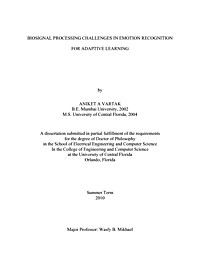
Biosignal processing challenges in emotion recognition for adaptive learning
User-centered computer based learning is an emerging field of interdisciplinary research. Research in diverse areas such as psychology, computer science, neuroscience and signal processing is making contributions to take this field to the next level. Learning systems built using contributions from these fields could be used in actual training and education instead of just laboratory proof-of-concept. One of the important advances in this research is the detection and assessment of the cognitive and emotional state of the learner using such systems. This capability moves development beyond the use of traditional user performance metrics to include system intelligence measures that are based on current theories in neuroscience. These advances are of paramount importance in the success and wide spread use of learning systems that are automated and intelligent. Emotion is considered an important aspect of how learning occurs, and yet estimating it and making adaptive adjustments are not part of most learning systems. In this research we focus on one specific aspect of constructing an adaptive and intelligent learning system, that is, estimation of the emotion of the learner as he/she is using the automated training system. The challenge starts with the definition of the emotion and the utility of it in human life. The next challenge is to measure the co-varying factors of the emotions in a non-invasive way, and find consistent features from these measures that are valid across wide population. In this research we use four physiological sensors that are non-invasive, and establish a methodology of utilizing the data from these sensors using different signal processing tools. A validated set of visual stimuli used worldwide in the research of emotion and attention, called International Affective Picture System (IAPS), is used. A dataset is collected from the sensors in an experiment designed to elicit emotions from these validated visual stimuli. We describe a novel wavelet method to calculate hemispheric asymmetry metric using electroencephalography data. This method is tested against typically used power spectral density method. We show overall improvement in accuracy in classifying specific emotions using the novel method. We also show distinctions between different discrete emotions from the autonomic nervous system activity using electrocardiography, electrodermal activity and pupil diameter changes. Findings from different features from these sensors are used to give guidelines to use each of the individual sensors in the adaptive learning environment.
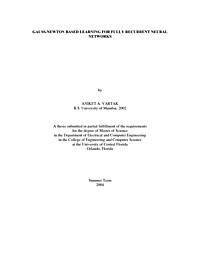
Gauss-Newton Based Learning for Fully Recurrent Neural Networks
The thesis discusses a novel off-line and on-line learning approach for Fully Recurrent Neural Networks (FRNNs). The most popular algorithm for training FRNNs, the Real Time Recurrent Learning (RTRL) algorithm, employs the gradient descent technique for finding the optimum weight vectors in the recurrent neural network. Within the framework of the research presented, a new off-line and on-line variation of RTRL is presented, that is based on the Gauss-Newton method. The method itself is an approximate Newton’s method tailored to the specific optimization problem, (non-linear least squares), which aims to speed up the process of FRNN training. The new approach stands as a robust and effective compromise between the original gradient-based RTRL (low computational complexity, slow convergence) and Newton-based variants of RTRL (high computational complexity, fast convergence). By gathering information over time in order to form Gauss-Newton search vectors, the new learning algorithm, GN-RTRL, is capable of converging faster to a better quality solution than the original algorithm. Experimental results reflect these qualities of GN-RTRL, as well as the fact that GN-RTRL may have in practice lower computational cost in comparison, again, to the original RTRL.
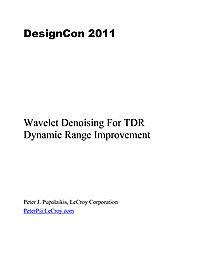
Wavelet Denoising for TDR Dynamic Range Improvement
A technique is presented for removing large amounts of noise present in time-domain-reflectometry (TDR) waveforms to increase the dynamic range of TDR waveforms and TDR based s-parameter measurements.
Bilinear Transformation Made Easy
A formula is derived and demonstrated that is capable of directly generating digital filter coefficients from an analog filter prototype using the bilinear transformation. This formula obviates the need for any algebraic manipulation of the analog prototype filter and is ideal for use in embedded systems that must take in any general analog filter specification and dynamically generate digital filter coefficients directly usable in difference equations.
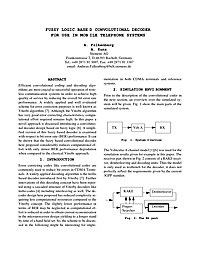
FUZZY LOGIC BASED CONVOLUTIONAL DECODER FOR USE IN MOBILE TELEPHONE SYSTEMS
Efficient convolutional coding and decoding algorithms are most crucial to successful operation of wireless communication systems in order to achieve high quality of service by reducing the overall bit error rate performance. A widely applied and well evaluated scheme for error correction purposes is well known as Viterbi algorithm [7]. Although the Viterbi algorithm has very good error correcting characteristics, computational effort required remains high. In this paper a novel approach is discussed introducing a convolutional decoder design based on fuzzy logic. A simplified version of this fuzzy based decoder is examined with respect to bit error rate (BER) performance. It can be shown that the fuzzy based convolutional decoder here proposed considerably reduces computational effort with only minor BER performance degradation when compared to the classical Viterbi approach.
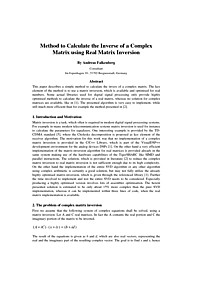
Method to Calculate the Inverse of a Complex Matrix using Real Matrix Inversion
This paper describes a simple method to calculate the invers of a complex matrix. The key element of the method is to use a matrix inversion, which is available and optimised for real numbers. Some actual libraries used for digital signal processing only provide highly optimised methods to calculate the inverse of a real matrix, whereas no solution for complex matrices are available, like in [1]. The presented algorithm is very easy to implement, while still much more efficient than for example the method presented in [2]. [1] Visual DSP++ 4.0 C/C++ Compiler and Library Manual for TigerSHARC Processors; Analog Devices; 2005. [2] W. Press, S.A. Teukolsky, W.T. Vetterling, B.R. Flannery; Numerical Recipes in C++, The art of scientific computing, Second Edition; p52 : “Complex Systems of Equations”;Cambridge University Press 2002.
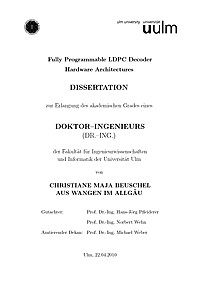
Fully Programmable LDPC Decoder Hardware Architectures
In recent years, the amount of digital data which is stored and transmitted for private and public usage has increased considerably. To allow a save transmission and storage of data despite of error-prone transmission media, error correcting codes are used. A large variety of codes has been developed, and in the past decade low-density parity-check (LDPC) codes which have an excellent error correction performance became more and more popular. Today, low-density parity-check codes have been adopted for several standards, and efficient decoder hardware architectures are known for the chosen structured codes. However, the existing decoder designs lack flexibility as only few structured codes can be decoded with one decoder chip. In consequence, different codes require a redesign of the decoder, and few solutions exist for decoding of codes which are not quasi-cyclic or which are unstructured. In this thesis, three different approaches are presented for the implementation of fully programmable LDPC decoders which can decode arbitrary LDPC codes. As a design study, the first programmable decoder which uses a heuristic mapping algorithm is realized on an field-programmable gate array (FPGA), and error correction curves are measured to verify the correct functionality. The main contribution of this thesis lies in the development of the second and the third architecture and an appropriate mapping algorithm. The proposed fully programmable decoder architectures use one-phase message passing and layered decoding and can decode arbitrary LDPC codes using an optimum mapping and scheduling algorithm. The presented programmable architectures are in fact generalized decoder architectures from which the known decoders architectures for structured LDPC codes can be derived.
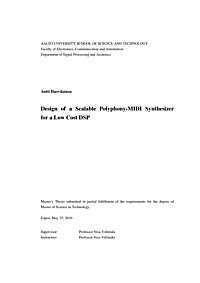
Design of a Scalable Polyphony-MIDI Synthesizer for a Low Cost DSP
In this thesis, the design of a music synthesizer implementing the Scalable Polyphony-MIDI soundset on a low cost DSP system is presented. First, the SP-MIDI standard and the target DSP platform are presented followed by review of commonly used synthesis techniques and their applicability to systems with limited computational and memory resources. Next, various oscillator and filter algorithms used in digital subtractive synthesis are reviewed in detail. Special attention is given to the aliasing problem caused by discontinuities in classical waveforms, such as sawtooth and pulse waves and existing methods for bandlimited waveform synthesis are presented. This is followed by review of established structures for computationally efficient time-varying filters. A novel digital structure is presented that decouples the cutoff and resonance controls. The new structure is based on the analog Korg MS-20 lowpass filter and is computationally very efficient and well suited for implementation on low bitdepth architectures. Finally, implementation issues are discussed with emphasis on the Differentiated Parabole Wave oscillator and MS-20 filter structures and the effects of limited computational capability and low bitdepth. This is followed by designs for several example instruments.
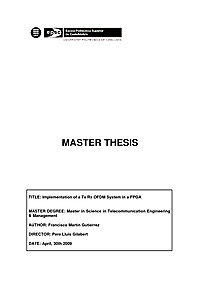
Implementation of a Tx/Rx OFDM System in a FPGA
The aim of this project consists in the FPGA design and implementation of a transmitter and receiver (Tx/Rx) multicarrier system such the Orthogonal Frequency Division Multiplexing (OFDM). This Tx/Rx OFDM subsystem is capable to deal with with different M-QAM modulations and is implemented in a digital signal processor (DSP-FPGA). The implementation of the Tx/Rx subsystem has been carried out in a FPGA using both System Generator visual programming running over Matlab/Simulink, and the Xilinx ISE program which uses VHDL language. This project is divided into four chapters, each one with a concrete objective. The first chapter is a brief introduction to the digital signal processor used, a field-programmable gate array (FPGA), and to the VHDL programming language. The second chapter is an overview on OFDM, its main advantages and disadvantages in front of previous systems, and a brief description of the different blocks composing the OFDM system. Chapter three provides the implementation details for each of these blocks, and also there is a brief explanation on the theory behind each of the OFDM blocks to provide a better comprehension on its implementation. The fourth chapter is focused, on the one hand, in showing the results of the Matlab/Simulink simulations for the different simulation schemes used and, on the other hand, to show the experimental results obtained using the FPGA to generate the OFDM signal at baseband and then upconverted at the frequency of 3,5 GHz. Finally the conclusions regarding the whole Tx/Rx design and implementation of the OFDM subsystem are given.
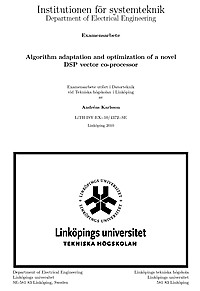
Algorithm Adaptation and Optimization of a Novel DSP Vector Co-processor
The Division of Computer Engineering at Linköping's university is currently researching the possibility to create a highly parallel DSP platform, that can keep up with the computational needs of upcoming standards for various applications, at low cost and low power consumption. The architecture is called ePUMA and it combines a general RISC DSP master processor with eight SIMD co-processors on a single chip. The master processor will act as the main processor for general tasks and execution control, while the co-processors will accelerate computing intensive and parallel DSP kernels.This thesis investigates the performance potential of the co-processors by implementing matrix algebra kernels for QR decomposition, LU decomposition, matrix determinant and matrix inverse, that run on a single co-processor. The kernels will then be evaluated to find possible problems with the co-processors' microarchitecture and suggest solutions to the problems that might exist. The evaluation shows that the performance potential is very good, but a few problems have been identified, that causes significant overhead in the kernels. Pipeline mismatches, that occurs due to different pipeline lengths for different instructions, causes pipeline hazards and the current solution to this, doesn't allow effective use of the pipeline. In some cases, the single port memories will cause bottlenecks, but the thesis suggests that the situation could be greatly improved by using buffered memory write-back. Also, the lack of register forwarding makes kernels with many data dependencies run unnecessarily slow.
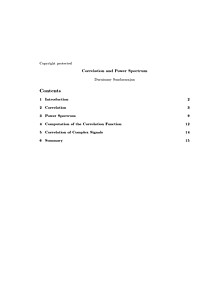
Correlation and Power Spectrum
In the signals and systems course and in the first course in digital signal processing, a signal is, most often, characterized by its amplitude spectrum in the frequency-domain and its amplitude profile in the time-domain. So much a student gets used to this type of characterization, that the student finds it difficult to appreciate, when encountered in the ensuing statistical signal processing course, the fact that a signal can also be characterized by its autocorrelation function in the time-domain and the corresponding power spectrum in the frequency-domain and that the amplitude characterization is not available. In this article, the characterization of a signal by its autocorrelation function in the time-domain and the corresponding power spectrum in the frequency-domain is described. Cross-correlation of two signals is also presented.
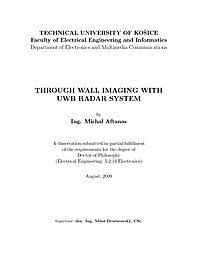
Through-Wall Imaging with UWB Radar System
Motivation: A man was interested in knowing of unknown from the very beginning of the human history. Our human eyes help us to investigate our environment by reflection of light. However, wavelengths of visible light allows transparent view through only a very small kinds of materials. On the other hand, Ultra WideBand (UWB) electromagnetic waves with frequencies of few Gigahertz are able to penetrate through almost all types of materials around us. With some sophisticated methods and a piece of luck we are able to investigate what is behind opaque walls. Rescue and security of the people is one of the most promising fields for such applications. Rescue: Imagine how useful can be information about interior of the barricaded building with terrorists and hostages inside for a policemen. The tactics of police raid can be build up on realtime information about ground plan of the room and positions of big objects inside. How useful for the firemen can be information about current interior state of the room before they get inside? Such hazardous environment, full of smoke with zero visibility, is very dangerous and each additional information can make the difference between life and death. Security: Investigating objects through plastic, rubber, dress or other nonmetallic materials could be highly useful as an additional tool to the existing x-ray scanners. Especially it could be used for scanning baggage at the airport, truckloads on borders, dangerous boxes, etc.

Efficient Digital Fiilters
What would you do in the following situation? Let ’ s say you are diagnosing a DSP system problem in the field. You have your trusty laptop with your development system and an emulator. You figure out that there was a problem with the system specifications and a symmetric FIR filter in the software won ’ t do the job; it needs reduced passband ripple, or maybe more stopband attenuation. You then realize you don ’ t have any filter design software on the laptop, and the customer is getting angry. The answer is easy: You can take the existing filter and sharpen it. Simply stated, filter sharpening is a technique for creating a new filter from an old one [1] – [3] . While the technique is almost 30 years old, it is not generally known by DSP engineers nor is it mentioned in most DSP textbooks.
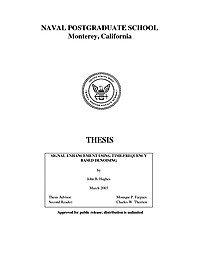
Ignal Enhancement Using Time-Frequency Based Denoising
This thesis investigates and compares time and wavelet-domain denoising techniques where received signals contain broadband noise. We consider how time and wavelet-domain denoising schemes and their combinations compare in the mean squared error sense. This work applies Wiener prediction and Median filtering as they do not require any prior signal knowledge. In the wavelet-domain we use soft or hard thresholding on the detail coefficients. In addition, we explore the effect of these wavelet-domain thresholding techniques on the coefficients associated with cycle-spinning and the newly proposed recursive cycle-spinning scheme. Finally, we note that thresholding does not make an attempt to de-noise coefficients that remain after thresholding; therefore we apply time domain techniques to the remaining detail coefficients from the first level of decomposition in an attempt to de-noise them further prior to reconstruction. This thesis applies and compares these techniques using a mean squared error criterion to identify the best performing in a robust test signal environment. We find that soft thresholding with Stein’s Unbiased Risk Estimate (SURE) thresholding produces the best mean squared error results in each test case and that the addition of Wiener prediction to the first level of decomposition coefficients leads to a slightly enhanced performance. Finally, we illustrate the effects of denoising algorithms on longer data segments.
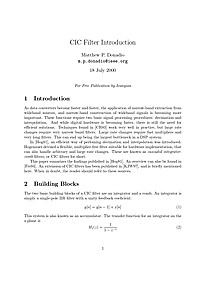
Cascaded Integrator-Comb (CIC) Filter Introduction
In the classic paper, "An Economical Class of Digital Filters for Decimation and Interpolation", Hogenauer introduced an important class of digital filters called "Cascaded Integrator-Comb", or "CIC" for short (also sometimes called "Hogenauer filters"). Here, Matthew Donadio provides a more gentle introduction to the subject of CIC filters, geared specifically to the needs of practicing DSP designers.
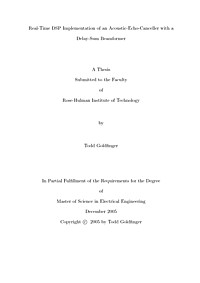
Real-Time DSP Implementation of an Acoustic-Echo-Canceller with a Delay-Sum Beamformer
Traditional telephony uses only a single receiver for speech acquisition. If the speaker is standing away from the telephone, the signal will be weak and there will be interference sources from room reverberation. In addition, there is acoustic echo coming from the loudspeaker, which further interferes with the signal of interest. This research investigated the combination of common solutions to these problems. Electronic beamforming steered an array of microphones within software to enhance the signal power. Echo cancellation removed the echo coming from the loudspeaker. In combination these processing techniques can greatly enhance user experience.
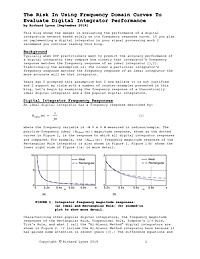
The Risk In Using Frequency Domain Curves To Evaluate Digital Integrator Performance
This article shows the danger in evaluating the performance of a digital integration network based solely on its frequency response curve. If you plan on implementing a digital integrator in your signal processing work I recommend you continue reading this article.
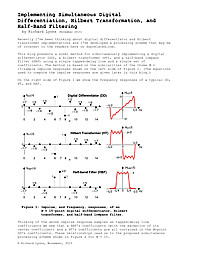
Implementing Simultaneous Digital Differentiation, Hilbert Transformation, and Half-Band Filtering
Recently I've been thinking about digital differentiator and Hilbert transformer implementations and I've developed a processing scheme that may be of interest to the readers here on dsprelated.com.
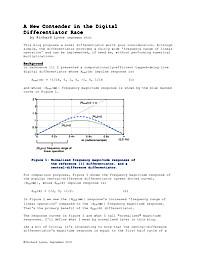
A New Contender in the Digital Differentiator Race
This blog proposes a novel differentiator worth your consideration. Although simple, the differentiator provides a fairly wide 'frequency range of linear operation' and can be implemented, if need be, without performing numerical multiplications.



















